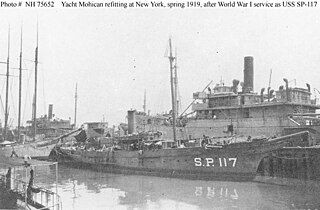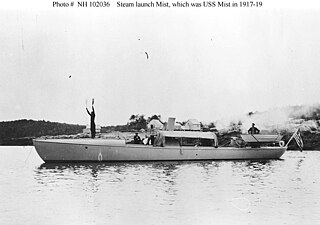
USS Kanawha II (SP-130)/USS Piqua (SP-130) -- was a yacht acquired by the U.S. Navy during World War II. She was placed into service as an escort for Allied convoys traveling across the dangerous North Atlantic Ocean. German U-boats were active in sinking Allied ships, and Kanawha II provided a valuable service as a lookout and in one instance attacked one and drove it off. Post-war she was returned to her pre-war owner in July 1919.

USS Druid (SP-321) was a private yacht launched 10 February 1902 as Rheclair that was built for Daniel G. Reid. Reid sold the yacht to Senator Nelson W. Aldrich who renamed the yacht Nirvana only just over a year before his death. Aldrich's estate chartered Nirvana to John Wanamaker until it was bought by his son Rodman Wanamaker who used the yacht for cruising until a fire on 14 December 1916, just before a cruise south, severely damaged the vessel. He chartered an alternate vessel for his trip south and, after full repairs, the yacht was sold to Walter W. Dwyer who gave it the name Druid with intentions to sell the yacht to the government in order to finance a shipyard venture in Pensacola, Florida.

USS Wanderlust (SP-923) was a patrol vessel that served in the United States Navy from 1917 to 1919.

USS Lynx II (SP-730), later USS SP-730, was an armed motorboat that served in the United States Navy as a patrol vessel and harbor dispatch boat from 1917 to 1919.

USS Joyance (SP-72) was an armed yacht that served in the United States Navy as a patrol vessel from 1917 to 1919.

USS Shadow III (SP-102) was an armed motorboat that served in the United States Navy as a patrol vessel from 1917 to 1919.

The third USS Mohican (SP-117), later USS SP-117, was an armed yacht that served in the United States Navy as a patrol vessel from 1917 to 1919.
USS Kathrich II (SP-148) was a motorboat that served in the United States Navy as a patrol vessel from 1917 to 1919.

USS Apache (SP-729) was the first to be delivered of eight motor boats built by Herreshoff Manufacturing Company at Bristol, Rhode Island ordered and financed by members of the Eastern Yacht Club of Marblehead, Massachusetts. The boats were designed by Albert Loring Swasey and Nathanael Greene Herreshoff with the intention that the boats be used by the Navy as patrol craft and built with Navy approval of the design. Apache, as were the other boats, bore names under construction chosen by the owners and were then given the Section Patrol numbers on Navy acceptance and activation. The names were dropped after a period and all the boats then bore only the S.P. numbers.

USS Hopestill (SP-191) was a United States Navy patrol vessel in commission from 1917 to 1919.

USS Wemootah (SP-201) was a United States Navy patrol vessel and net tender in commission from 1917 to 1919.

USS Nirvana (SP-706), later USS SP-706, was a United States Navy patrol vessel in commission in 1917 and from 1918 to 1919.

USS Hobcaw (SP-252) was a United States Navy patrol vessel, towing boat, and ferryboat in commission from 1917 to 1918.
USS Lowell (SP-504) was a United States Navy patrol vessel and minesweeper in commission from 1917 to 1919.

USS Navajo III (SP-298), later USS SP-298, was an armed motorboat that served in the United States Navy as a patrol vessel from 1917 to 1919.

The second USS Mist (SP-567) was a United States Navy patrol vessel in commission from 1917 to 1919.

USS Satilla (SP-687) was a United States Navy patrol vessel in commission from 1917 to 1919.

The first USS Vision (SP-744), later USS SP-744, was a United States Navy patrol vessel in commission from 1917 to 1919.
USS Lagoda (SP-3250) was a United States Navy patrol vessel in commission from 1918 to 1919.

USS Helianthus (SP-585) was a patrol vessel in commission in the United States Navy from 1917 to 1919, seeing service in World War I. After her U.S. Navy service, she was in commission in the United States Coast and Geodetic Survey as the survey launch USC&GS Helianthus from 1919 to 1939. She was named after the Helianthus, the genus to which the sunflower belongs.
















